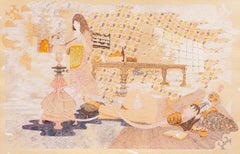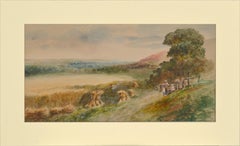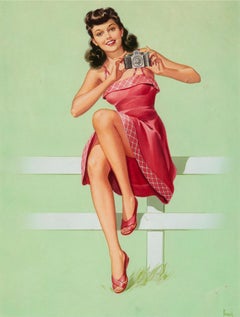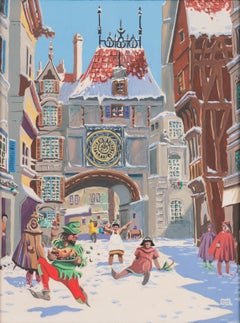Illustration Board Figurative Drawings and Watercolors
1940s Art Deco Illustration Board Figurative Drawings and Watercolors
Illustration Board, Gouache, Watercolor
1960s Modern Illustration Board Figurative Drawings and Watercolors
Ink, Illustration Board
Late 19th Century American Impressionist Illustration Board Figurative Drawings and Watercolors
Watercolor, Illustration Board, Laid Paper
2010s Contemporary Illustration Board Figurative Drawings and Watercolors
Acrylic, Illustration Board, Pencil
1940s American Realist Illustration Board Figurative Drawings and Watercolors
Watercolor, Illustration Board
1960s Realist Illustration Board Figurative Drawings and Watercolors
Gouache, Illustration Board
1930s Art Deco Illustration Board Figurative Drawings and Watercolors
Crayon, Watercolor, Gouache, Illustration Board, Pen, Pencil
Early 1900s Academic Illustration Board Figurative Drawings and Watercolors
Paper, Watercolor, Illustration Board
1980s Other Art Style Illustration Board Figurative Drawings and Watercolors
Watercolor, Gouache, Illustration Board
Early 20th Century Impressionist Illustration Board Figurative Drawings and Watercolors
Gouache, Illustration Board
1960s Photorealist Illustration Board Figurative Drawings and Watercolors
Gouache, Illustration Board
1930s Art Nouveau Illustration Board Figurative Drawings and Watercolors
Watercolor, Ink, Illustration Board
1890s American Impressionist Illustration Board Figurative Drawings and Watercolors
India Ink, Illustration Board
1960s Conceptual Illustration Board Figurative Drawings and Watercolors
Ink, Watercolor, Gouache, Illustration Board, Pencil
1920s Impressionist Illustration Board Figurative Drawings and Watercolors
Paper, Watercolor, Illustration Board
1950s Illustration Board Figurative Drawings and Watercolors
Ink, Illustration Board, Pen
1960s Illustration Board Figurative Drawings and Watercolors
Ink, Illustration Board, Pen
1950s Realist Illustration Board Figurative Drawings and Watercolors
Gouache, Illustration Board, Ink
1930s Naturalistic Illustration Board Figurative Drawings and Watercolors
Archival Ink, Watercolor, Illustration Board
2010s Contemporary Illustration Board Figurative Drawings and Watercolors
Watercolor, Illustration Board
1980s Contemporary Illustration Board Figurative Drawings and Watercolors
Oil Pastel, Illustration Board
1990s Realist Illustration Board Figurative Drawings and Watercolors
Watercolor, Gouache, Illustration Board
1940s Illustration Board Figurative Drawings and Watercolors
Gouache, Illustration Board
1930s Illustration Board Figurative Drawings and Watercolors
Charcoal, Illustration Board
Early 1900s Art Nouveau Illustration Board Figurative Drawings and Watercolors
Ink, Illustration Board, Pen
1960s American Realist Illustration Board Figurative Drawings and Watercolors
Ink, Gouache, Illustration Board
1960s Illustration Board Figurative Drawings and Watercolors
Ink, Illustration Board, Pen
1950s Illustration Board Figurative Drawings and Watercolors
Ink, Illustration Board, Pen
1950s Illustration Board Figurative Drawings and Watercolors
Gouache, Illustration Board
Late 20th Century Pop Art Illustration Board Figurative Drawings and Watercolors
Paper, Charcoal, Illustration Board, Cardboard, Carbon Pencil
1940s Illustration Board Figurative Drawings and Watercolors
Ink, Illustration Board, Pen
1940s Illustration Board Figurative Drawings and Watercolors
Illustration Board, Ink, Pen
1940s Illustration Board Figurative Drawings and Watercolors
Ink, Illustration Board, Pen
1960s Illustration Board Figurative Drawings and Watercolors
Ink, Illustration Board, Pen
1930s Art Deco Illustration Board Figurative Drawings and Watercolors
Gouache, Illustration Board, Pen, Pencil
1960s Conceptual Illustration Board Figurative Drawings and Watercolors
Ink, Gouache, Illustration Board, Pen
1930s American Impressionist Illustration Board Figurative Drawings and Watercolors
Conté, Postcard, Illustration Board
20th Century Illustration Board Figurative Drawings and Watercolors
Watercolor, Illustration Board
1960s American Realist Illustration Board Figurative Drawings and Watercolors
Watercolor, Gouache, Illustration Board
Early 20th Century Realist Illustration Board Figurative Drawings and Watercolors
Paper, Watercolor, Gouache, Illustration Board
1920s Surrealist Illustration Board Figurative Drawings and Watercolors
Illustration Board, Watercolor, Gouache
Late 19th Century Impressionist Illustration Board Figurative Drawings and Watercolors
Watercolor, Postcard, Illustration Board
1930s Academic Illustration Board Figurative Drawings and Watercolors
Watercolor, Gouache, Illustration Board
Early 20th Century Contemporary Illustration Board Figurative Drawings and Watercolors
Paper, Charcoal, Illustration Board
1930s Naturalistic Illustration Board Figurative Drawings and Watercolors
Archival Ink, Watercolor, Illustration Board
2010s Contemporary Illustration Board Figurative Drawings and Watercolors
Acrylic, Pencil, Illustration Board
2010s Contemporary Illustration Board Figurative Drawings and Watercolors
Acrylic, Pencil, Illustration Board
1970s Illustration Board Figurative Drawings and Watercolors
Watercolor, Illustration Board
1920s Impressionist Illustration Board Figurative Drawings and Watercolors
Paper, Pastel, Illustration Board
2010s Contemporary Illustration Board Figurative Drawings and Watercolors
Acrylic, Pencil, Illustration Board
1990s Illustration Board Figurative Drawings and Watercolors
Mixed Media, Illustration Board, Graphite
1930s American Modern Illustration Board Figurative Drawings and Watercolors
India Ink, Watercolor, Illustration Board
1930s American Modern Illustration Board Figurative Drawings and Watercolors
India Ink, Watercolor, Illustration Board
Early 1900s Victorian Illustration Board Figurative Drawings and Watercolors
Watercolor, Illustration Board, Board
1930s Art Deco Illustration Board Figurative Drawings and Watercolors
India Ink, Watercolor, Illustration Board
1980s Contemporary Illustration Board Figurative Drawings and Watercolors
Oil Pastel, Illustration Board
1980s Illustration Board Figurative Drawings and Watercolors
Oil Pastel, Illustration Board
1990s Contemporary Illustration Board Figurative Drawings and Watercolors
Oil Pastel, Illustration Board
1930s Illustration Board Figurative Drawings and Watercolors
Ink, Illustration Board, Gouache, Pencil
1990s Contemporary Illustration Board Figurative Drawings and Watercolors
Oil Pastel, Illustration Board




